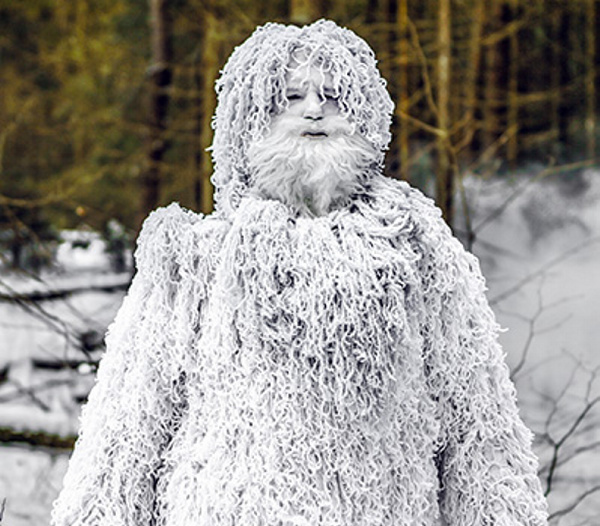My boyfriend blames my excessive, expanding throw-pillow collection on Portland’s International Cryptozoology Museum.
This is because last year, we went to the vendors hall at the International Cryptozoology Conference and I bought a really swell handmade throw pillow (made by Neko-jin Designs, a Stockton Springs-based crafter) that had a giant squid on it. And I love me some giant squid. (Did you know that the very first photos of a live giant squid were only taken in 2004?) When I got home, I noticed that my funky new throw pillow looked lonely on the couch, I thought another throw pillow would be good, and now there is no more couch left.
But if you aren’t susceptible to the collecting of strange cushions, and you’re looking for something to do on the weekend in this weird, wet, cold season of not-quite-spring and isn’t-winter-done-yet, I really recommend visiting the museum. It’s the only museum dedicated to cryptozoology in the world. Admission is $10 for adults and $5 for children – cheaper than the movies – and it’s got something for every member of the family: a giant Bigfoot statue for teenage Instagram selfies, old monster-movie artifacts for film buffs, a collection of Wessie-related artifacts for locals who remember that time last year when a python was loose in Westbrook. (These things, they happen.) And, of course, for adults 21 and over who can drink alcohol without their life spiraling entirely downward (not me, of course), Thompson’s Point has a brewery, a winery AND a distillery. There’s also the beautiful views and scenery of the point (bring a jacket, it’s windy) and ample parking, a rarity in Portland.
Cryptozoology is defined as the study of animals that have not yet been proven to exist. Those critters are referred to as “cryptids.” The words come from the Greek “kryptos,” meaning “hidden” or “secret.” Some people think cryptozoology just means a bunch of crazy Bigfoot people. And sure, there are definitely crazy Bigfoot people. (Including, of course, Sir Edmund Hillary, one of the first men to scale Mount Everest, who mounted an expedition to research the Himalayan Yeti … and, of course, Denver Riggleman, current U.S. representative from Virginia.) But I think of cryptozoology – the study of creatures that have not been proven to exist – as more than that. It’s not just about facts, numbers and DNA tests. Cryptozoologists are the collectors of legends.
Is it a coincidence that many diverse peoples and cultures all have similar legends and stories about, for example, sea serpents? Dragons? Large hairy men living in the woods? (OK, that last one could also describe all of Maine, in addition to Bigfoot.)
I’m somewhere between Mulder and Scully in terms of my belief in what’s out there. Seals are probably the only thing in Loch Ness, but it’s a little bit presumptuous to think that we humans have discovered everything there is to discover about our Earth, isn’t it? That it’s not possible that, somewhere out there in the deepest oceans or on the highest mountains, there are creatures that have not been added to the rolls of science?
I like stories. (This is probably not a surprise to anyone.)
I like stories about the natural world, the ancient world, the modern world; I like stories about people experiencing the impossible; I love a good mystery. The cryptozoology museum is a good place to explore those stories and let your mind wiggle around for explanations. How reliable is that evidence? What other explanation for this story could be plausible? Where did this legend come from? Is that plaster cast even a footprint?
When I look up at the stars on a clear night, and suddenly hear a rustle in the copse of trees across the road – that’s the feeling that cryptozoology gives me, that little jump in my chest, that maybe-just-maybe. I like the idea that there could be something out there. I like the idea that there could maybe-just-maybe be Tasmanian tigers somewhere in the wild, that humans didn’t just wipe them all out.
In fact, perhaps my fascination with cryptozoology has to do with my millennial guilt over the damage humanity is doing to the natural world through climate change and years of environmental degradation. We drill and mine and clear-cut forests without regard for other living organisms. We destroy the Earth’s mysteries before we even have a chance to explore them. The cryptozoology museum is a good place to ponder what we could theoretically (very, very theoretically) lose if we keep it up.
Besides, climate change probably makes Bigfoot mad. And you don’t want to make a Bigfoot mad.
Victoria Hugo-Vidal is a Maine millennial. She can be contacted at:
Twitter: mainemillennial
Copy the Story LinkSend questions/comments to the editors.



Success. Please wait for the page to reload. If the page does not reload within 5 seconds, please refresh the page.
Enter your email and password to access comments.
Hi, to comment on stories you must . This profile is in addition to your subscription and website login.
Already have a commenting profile? .
Invalid username/password.
Please check your email to confirm and complete your registration.
Only subscribers are eligible to post comments. Please subscribe or login first for digital access. Here’s why.
Use the form below to reset your password. When you've submitted your account email, we will send an email with a reset code.